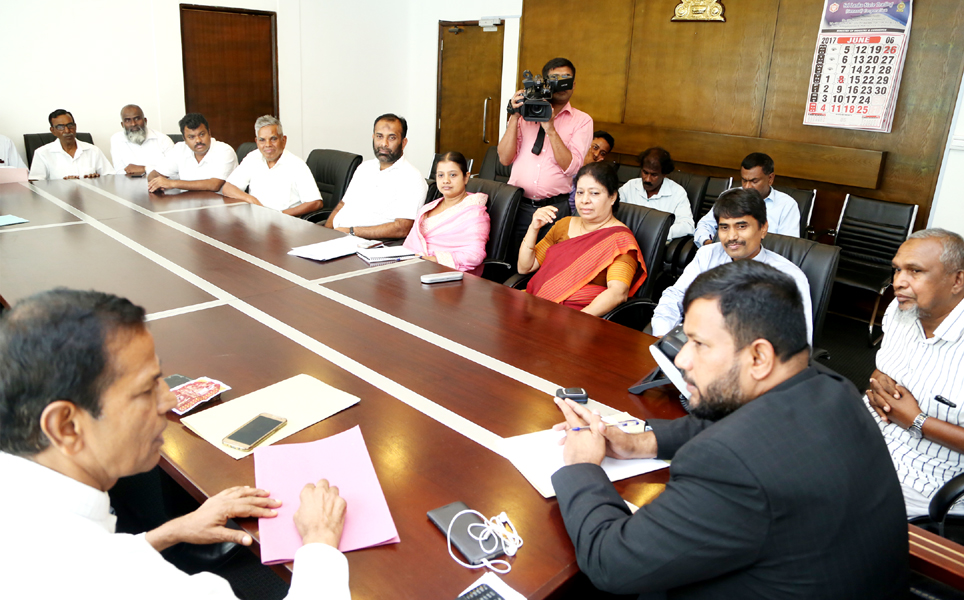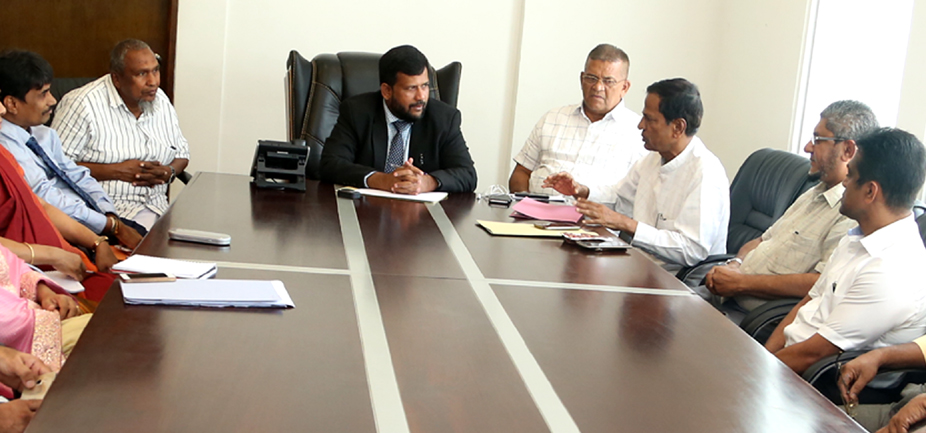A powerful but a perturbed retail market supplier collective in Sri Lanka voiced that the prohibited market practice of mixing imported and domestically milled rice could be overcome with a simple move, instead of resorting to punitive official raids. Meeting the Minister of Industry and Commerce Rishad Bathiudeen in earnest on June 1, Colombo Traders Association (CTA) also said that Maximum Retail Prices, imposed by the government have become an impediment, hampering Lankan consumer well-being, rather than improving it.
The June 1 meeting, specially called by Minister Bathiudeen to hear the grievances of supply side of the retail sector, was attended by CTA. 90% of its 210 members are large volume importers & distributors and committed tax payers. Most of these members regularly pay up taxes to the Inland Revenue Dept -not in mere million rupee range but in multi – billion Rupee levels! Top CTA reps at June 1 meet were Chairman of CTA YM Ibrahim (Chairman, Ishana Exports Pvt Ltd-a leading exporter of spice), CTA Deputy Chairman SM Zaneer (Chairman, KTC Group-the main importer of dates, raisins & sultanas for Lankan market and also a leading rice miller), and CTA Secretary Sooriyar (Chairman of Sooriyan Traders-large scale importer of essential food items to Sri Lanka).The meeting was also attended by Minister’s top officials in charge of retail (across such institutions as the Consumer Affairs Authority, the CWE and Lanka Sathosa).
“How can we realistically fix an MRP on an imported product for a long time-or even a short time?” asked CTA Deputy Chairman Zaneer and said: “Prices change seasonally and the dollar rate too fluctuates. The MRPs therefore should be changed very often to give the best to our consumers. But how often our MRPs change-if at all? We at CTA support that there should be an MRP for rice varieties which is our staple food. More importantly, there is a large local industry of farmers and millers who should be safeguarded. Rice MRPs therefore prevent consumer exploitation. But should other essentials too be given MRPs? Only small amounts of other items are locally produced but large volumes are imported. Even for rice, we believe that there should not be a practice of different prices for imported and domestic rices. A main reason for illegal mixing of rices is this arbitrary price structure. We propose equal prices for both imported and domestically milled rice in the local market. This can be done by a simple move -by increasing the duty on imported rice by as little as Rs 10 and no more. Raids are needed to prevent abuse but the present system of raiding is harsh and they show no mercy. Once my raided stocks were taken and destroyed even though all criteria fulfilled and the labels were in order. Then the wrong party was accused once –one of my product packs purchased by a seller that was unsold and kept in a corner in seller’s shop then later expired, was detected and instead of the seller I, the original manufacturer was accused since the label shows me as the manufacturer.”
Chairman of CTA, YM Ibrahim explained how MRPs often do not result in the ‘best price’ as intended. “The MRPs are imposed to safeguard the consumers, which we believe to be important. However, some members in our association do not see any benefit in maintaining the same MRP on certain products (other than rice) over a longer time. Our MRPs are not changing in line with the global market rates. In that, the MRPs are effective in the market at times of shortages, maintaining the price of the essential item without increasing it further. But unfortunately, often our MRPs continue to be enforced long after international market price of the same commodity has fallen even below the local MRP. As a result we find local consumers continue to pay higher prices for the item when the actual price of the commodity should be much lower. Also, when the international market price of the commodity is higher than local market MRP, then the importer is not able to import since the importer is bound to sell at the lower MRP incurring losses since they are compelled to sell at lower MRP than the international price. Therefore we are compelled to not to import at such times, which creates shortages in the market, hampering the consumer well-being and us also losing business in the meantime. The way to overcome this is by opening more towards global and dollar rates for essential items other than rice, and for rice, allowing a uniform price for both imported and locally milled rices. We propose a single, flat price tag for both locally milled and imported rice of same varieties by bringing in a simple import duty.”
Minister Bathiudeen responded: “I thank CTA for bringing these issues to my attention. Since MRPs and raids on errant traders are to safeguard consumers and directed by the Cost of Living Committee, CAA and higher levels of the government, I on my own, will not change its implementation. MRPs also need more study and closer watch. We are here to safeguard consumers and we focus on the market/demand side. Today for the first time we hear the supply side situation from CTA and these issues too need to be studied. I instruct you to make these representations and recommendations in writing immediately to me so that I will present it to higher levels to decide the way forward on giving best price & quality on all essential items.”
Selling essential items above the designated MRPs is an office in Sri Lanka. Chicken meat, red Dhal/lentils, spratts chickpeas, green grams, canned fish, white sugar, white flour, full cream milk powder, potatoes, Sustagen, B-onions, dried chillies, dried fish, and Maldive fish are among the items gazetted by the government as “Essential”.

